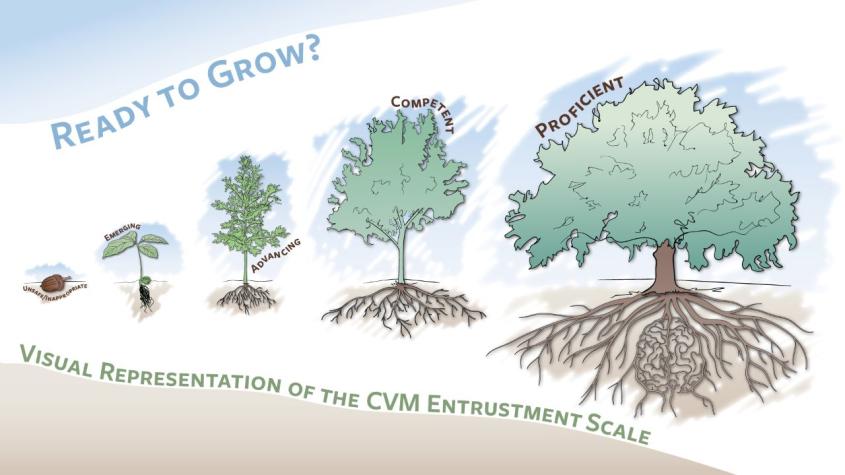A new era for clinical education at Cornell
Clinical rotations are an eagerly anticipated portion of a veterinary student’s training. Fourth-year students join integrated healthcare teams to serve a diverse array of animal patients throughout Cornell’s teaching hospitals and ambulatory services. In May 2023, the college launched a multi-year initiative to strengthen both teaching and learning on clinical rotations.
“Feedback from students and clinical instructors indicated that it was time for the college to undertake a re-design of the clinical curriculum to take advantage of advancements in clinical education and technologies, and to keep pace with the changing veterinary industry,” says Jodi Korich, D.V.M. ’97, associate dean for education. “A logical first step was to improve clinical assessment and trainee feedback to align with the college’s new competency-based curriculum. We also saw opportunities to provide more customized support to help all students reach their full potential.”
A new assessment scale
A team of faculty, administration and curriculum support staff was assembled in February, 2023 to begin the process of transforming the clinical curriculum. Letter grades were replaced with a five-point entrustment scale to allow clinical instructors to evaluate each student’s ability to perform a set of attributes safely and effectively. Standardized universal attributes are now evaluated on all rotations to provide consistency, allowing the program to track student performance longitudinally over time. Specialized attributes and service-specific attributes also allow rotations to assess additional attributes that are relevant to their rotation. “The goal is to have a system that allows for longitudinal tracking, thereby increasing the sensitivity and reliability of assessment. This sequential evaluation allows for early identification and targeted support of students that may be struggling with a certain component of clinical medicine,” says Daniel Lopez ’12, D.V.M. ’16, assistant clinical professor of small animal surgery and course leader for clinical rotations.

The new entrustment scale brings many benefits, including a more meaningful evaluation of the student’s readiness for day-one practice and greater insight into what they need to focus on to progress in their development. Instructors appreciate the simplicity of the new entrustment scale, which is more feasible to implement in the busy clinical workplace.
Broader feedback, better engagement
Another change in the assessment system is the breadth of feedback provided to students; now, all members of the clinical care team, including clinical faculty, Licensed Veterinary Technicians, interns and residents can score students on the attributes they have observed and provide written feedback on student performance using a new web-based assessment platform. “Multi-source feedback improves the reliability of student assessment and increases the volume of feedback provided,” says Lopez. “We’ve also seen the clinical community become more engaged in teaching and supporting students now that they have a more formal role to play in their assessment.”
Personal improvement plans
The student’s assessment scores are captured in a web-based reporting system; scores that do not meet the minimum performance level are flagged with students entering into a coaching program. The tiered coaching program begins with Tier 1, which pairs students with one of the five academic coaches who guides them through a self reflection exercise called a professional improvement plan. Students analyze their deficiency, develop a plan for improvement, and then implement their plan, monitoring their progress on subsequent rotations.
The goal of Tier 1 is to provide students with the time, support, and skills to self-evaluate their performance and make adjustments as needed moving forward. Ricardo de Matos, associate clinical professor of competency-based veterinary education curriculum development, who leads the academic coaching program, says, “We are pleased to see that students are approaching their professional improvement plans with a growth mindset. It’s not always easy for students to hear feedback that they need to improve. However, with the support of our coaches, students recognize the college is doing this to help them develop into competent and confident clinicians that can manage the challenges and demands of the veterinary profession. ”
Students who continue to struggle with a given attribute enter Tier 2 where they are paired with the Clinical Assessment and Teaching Support (CATS) team. The CATS system is designed to provide more intensive, one-on-one attribute-specific support to students. These students are given focused assignments and evaluations to monitor their progress more closely as they work to achieve competency by graduation.
“Ultimately, this new program provides the ability for students to accurately track their progress throughout their clinical year and implement feedback to improve,” says Jonathan Wood ’07, assistant clinical professor of neurology/neurosurgery and lead for the Stage 3 Clinical Redesign Team. “It also allows the college to identify and support struggling students in a tailored way, helping them become practice-ready.”
Community response
The D.V.M. Class of 2024 is the first class to engage with the new system and early feedback has been positive from across the community. “I think this has catalyzed some positive changes in our clinical community — we’ve moved away from a system where students were overly-focused on achieving letter grades and were rewarded for hiding gaps in their knowledge and skills,” says Korich. “Now, we have a system that meets each student where they are at and provides personalized support to help them work towards clinical proficiency. Our clinicians say that students are now asking more questions and being proactive about how they want to use their rotation to improve.”
Faculty feedback on the new approach has also been positive. “I appreciate the ability to give much more helpful feedback without automatically failing an underperforming student,” says Dr. Ursula Krotscheck, section chief of small animal surgery. “I anticipate that the usefulness of this system and the feedback it naturally generates will be much more likely to create practice-ready veterinarians than the previous grading system.”
While this is only the first step in reimagining clinical education at Cornell, it represents a significant advancement in our D.V.M. curriculum. “Making major changes like these requires teamwork. It’s exciting to see the community come together to think creatively and work collaboratively to improve clinical education at Cornell,” says Korich.
Written by Lauren Cahoon Roberts






